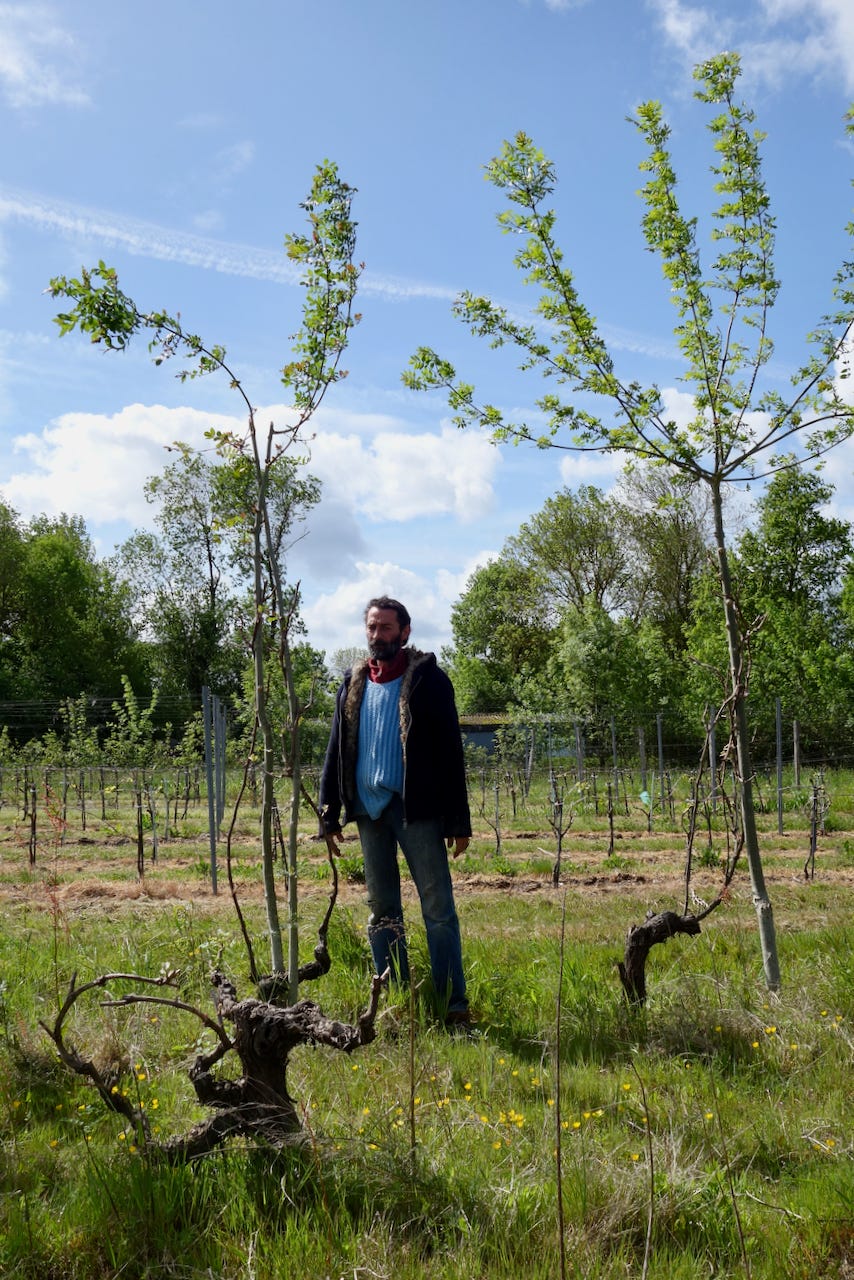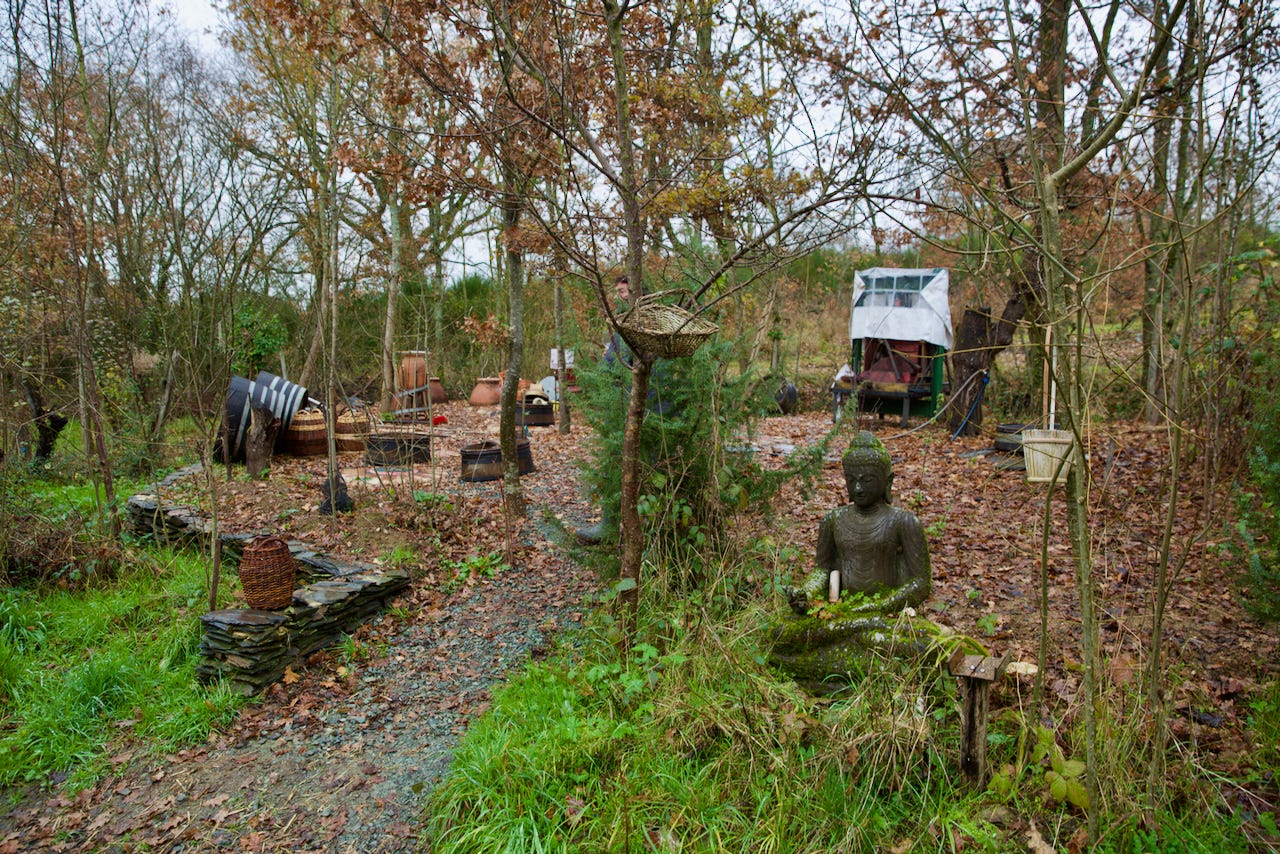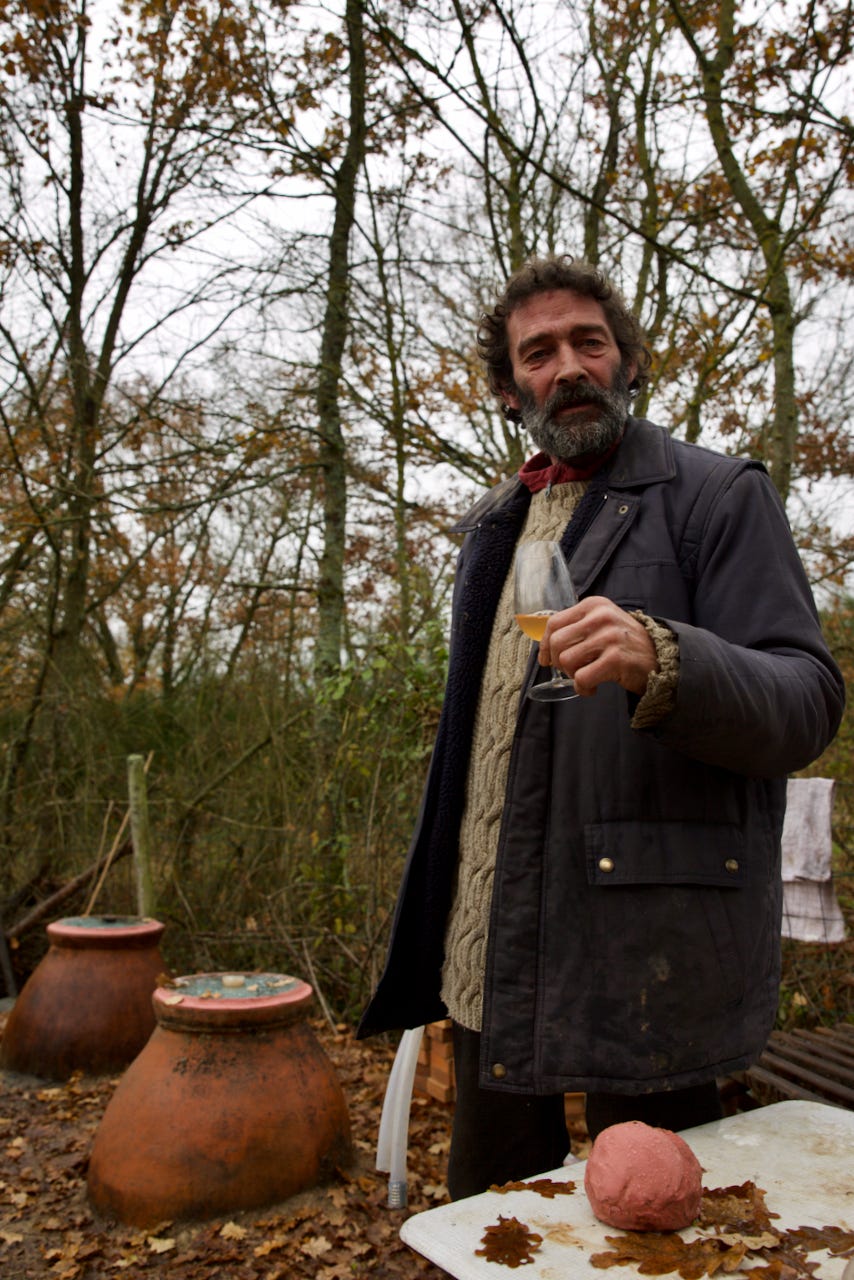Patrick Desplats' Qvevri Garden
2020 was Patrick Desplats' twentieth vintage. It's also the year he fully realized his radical vision of Georgian qvevri winemaking in Anjou.
From 2000-2010, Saint-Lambert-du-Lattay vigneron Patrick Desplats worked alongside Sébastien Dervieux (a.k.a. Babass) as Les Griottes, producing some of Anjou’s most influential, zero-zero natural wines. For Desplats, the 2010s were a period of wrenching personal and professional transition, as he ceased plowing, enduring a precipitous drop in yields plus a succession of frost vintages (2016-2019), and moved into an unelectrified shack he built beside his vines - all in service of a vision of “wine made without petrol.” In 2020, however, his efforts to radically reimagine the work of a vigneron came to fruition, in the form of fifteen full qvevris of unprecedented Anjou wine.
Quick Facts:
Patrick Desplats and Sébastien Dervieux split largely over the issue of plowing, with Dervieux preferring to continue the practice.
Solo, Desplats embraced many other viticultural gambits, including the ungrafted co-planting of twenty-five different grape varieties in his “Epona” vineyard, and training the hundred-year-old chenin vines that produce his cuvée “Caroline” upon saplings he planted beside them. He also abandoned Bordeaux mixture treatments for several years, although he resumed the practice in 2020.
Thierry Puzelat, upon learning about Desplats’ work training vines on trees, suggested Desplats visit Georgia, where the practice could still be found here and there.
Desplats visited Georgia for the first time in 2016. There Desplats fell in love with qvevri winemaking and resolved to adopt it in Anjou.
Desplats acquired and installed two qvevri in 2019, producing two wines, an orange wine and a red wine. These he unveiled among friends and visiting Georgian winemakers in January 2020, shortly before the Loire salons. The 2019 wines are in bottle and will be released in Spring 2021.
Desplats went all-in on qvevri vinification in 2020, installing thirteen more throughout the summer. He gave up the lease on his winery in Saint-Lambert-du-Lattay, moving all wine production to the garden surrounding his shack. This is where we tasted them in mid-December.
The wines are all already dry and remarkably limpid, with nary a trace of volatility. Though Desplats harvested later than most, at end September, his wines’ alcohol levels are strikingly low.
A SPECIAL RELATIONSHIP WITH NATURE

“If you’ve spoken to all the other vignerons about me, you’ve heard that I’m a bit unhinged,” Patrick Desplats told me when I first visited him in April 2019.
We were walking among the ungrafted vines of his “Epona” vineyard, admiring the hedges he’d recreated. “But I’m not unhinged. I just have a special relationship with nature.”
Desplats’ eccentric reputation precedes him, and he knows it. With his slight build, his lean visage, his frayed clothing, his manic energy, his steel-blue eyes, his air of having slept outside, Desplats resembles the fairytale beggar who is later revealed to be the Spirit of Christmas.
That same morning, I’d tried to persuade a friend, a local natural vigneron, to join me on the visit chez Desplats. I know he’s a bit eccentric, I conceded.
“Eccentric?” said my friend, who, like everyone in Anjou, lives in mild amazement of Desplats. “The last time I saw him, he wasn’t eating food. He told me he eats sunlight.”
In due course the subject of eating sunlight actually did come up in my conversation with Desplats. He was born prematurely, he says, and has never had much of an appetite, for food, at least. He mentioned meditating in the sun, for hours at a stretch, nourishing himself that way. After touring his vineyards that day we went to the Auberge du Layon and ate pizzas. I drove, because Desplats avoids using fuel whenever possible.
I’ve been fortunate to always catch Desplats in expansive, triumphant moods, happy to share his vision. In April 2019, he had just escaped frost that had devastated many of his neighbors’ vines. Peers like Philippe Delmée and Kenji Hodgson were despondent that month. Desplats attributed his vines’ resistance to the work he’d done that decade raising each plant, and to the warmth retained with his grass cover. In the vineyard named for his late plow-horse, “Caroline,” he showed me where he’d begun planting apple trees, pear trees, and fig trees throughout the parcel.
“What I noticed is that if I put the vine next to a tree, the vine climbs, but it’ll never go all the way up,” he said. “The idea is to create a forest. So the vine can climb. And then we’ll come and glean the grapes.”
Later that day, tasting his 2018 “Epona” from tank, I found myself struck by the wine’s unique balance of complexity and lightness. A young-vine, direct-press white composed of twenty-five different grape varieties, all planted franc de pied, it was at once dazzling and mild. It was perhaps 8 or 9° alcohol. The combination of low yields, permanent grass cover, and radical polyculture seemed primed to birth an entirely new wine genre.
Desplats notes that his project of agro-forestry and re-wilding is the work of a lifetime. It also proved not to be a foolproof solution to frost risk. A month after my visit, in May, a freak late frost destroyed much of Desplats’ 2019 harvest. As it happened, he had just enough grapes to fill two qvevri he’d buried that year.
On the January 2020 evening before the start of the Angers wine salons, Desplats convoked a congregation to taste from his two qvevris.
His garden-slash-residence is quite literally off-the-map outside of Saint-Lambert-du-Lattay; without a clear recollection of how to get there in the darkness, I followed cars that seemed to be heading into the wilderness. By the time I arrived, a sizeable crowd stood three-deep in pitch darkness around the open qvevri. I discerned friends: the wine journalist Alice Feiring, NYC sommelier Alex Alan, soon-to-be Savigny-lès-Beaune restauraratrice Lola Tiboury-Bize, Desplats’ US importer, Chris Terrell. Also in attendance was the band of Georgian vigneron(ne)s from whom Desplats had drawn inspiration: Ramaz Nikoladze, John Okro, John Wurdeman, Keti Berishvili, Tamuna Bidzinashvili. There was no discernible protocol. I found a glass somewhere and after some hesitation helped myself to a sip from each qvevri.
The red, at this stage, was forbiddingly tannic and reduced, though without cause for concern. The orange was magnificent, a success beyond all expectations. An electric, sienna-tinged vermilion, it packed ripe tannins, spiced nectarine fruit, and a muscle reminiscent of Kakheti (concentration resulting from the year’s drought and heatwave, as well as even-lower-than-usual yields). It was as though the qvevri was precisely the recipient Desplats’ fruit had been waiting for.
I barely exchanged a word with Desplats that night. Back over an anarchic dinner at his winery in Saint Lambert, he was in full-on prophet mode, embracing guests, raising toasts, inciting everyone to sing. To everyone gathered - not just Desplats - it seemed a relief that his qvevri vinifications had succeeded.
Shortly before returning to visit Desplats again in December, I purchased a few bottles of 2018 “Epona,” eager to recapture the magic of what we’d tasted from tank in 2019. But something appeared to have gone wrong in the bottling process. The wine is still preternaturally light. But the twinkle and spark have departed, replaced by oxidation, volatility, acetates, and a red-oniony nose. Desplats’ wines have always had the capacity to surprise. It will be a surprise indeed if this one bounces back.
When I arrive at Desplats’ compound a few days later, his daughter has just left. They’d been baking pear cakes in his outdoor kitchen, a sort of well-stocked hovel with a picnic table shaded by a blue tarp.
We smoke and he relays his happiness with the vintage, with the bevy of new qvevris he was able to fill.
The experience with his 2018 “Epona” has me concerned for the bottling of the 2019 orange wine I’d tasted in January. That is to remain a mystery, however: we don’t taste any of the 2019s. They’re in bottle, aging further in a cellar dug in the earth a few meters from his shack. Desplats plans to organize several events in the springtime to introduce the finished wine to his buyers en masse. (Quantities are tiny: just 1300 bottles and 300 magnums.)
Instead, Desplats leads me over to where I’d glimpsed the first two qvevri that January night. He beams, showing off his new winery, which is not a winery at all, but a sort of glade, landscaped flat, in which are now buried fifteen qvevri of varying size. Assembled in the open-air beside them are a few upturned wooden basins (for foulage) and wicker-lined glass carboys for topping-up. A small manual vertical press stands beneath a plastic sheet off to one side.
As Reinette, his muscular and affectionate cat, nuzzles our legs, Desplats siphons tastes from his baroque new range of qvevri wines. Every single one is dry, with malolactic fermentations all finished.
“Epona” is no longer a white wine, nor a discernibly orange wine. It’s a glowy, Valentine-pink. It’s crisp, red-fruited, with a sort of sweet lipstick aroma.
A macerated blend of chardonnay, sauvignon, and chenin is firm, pineapple-toned, yet much lighter (in both color and body) than his orange wine of 2019.
A pure cabernet sauvignon is sappy and intense, its ripe tannins belying its manifestly low alcohol.
Desplats plans to bottle each qvevri as distinct cuvées. But he notes that miscegenation is in the nature of qvevri winemaking.
“When I devat one, I’ll be missing wine inside. So I have little amphorae beside them, which will be used to fill it up.”
As much as he praises the traditions of Georgian winemaking, Desplats has modified them to his own tastes. He doesn’t destem anything, preferring thorough foulage before vatting. In 2020, most of his wines saw maceration for about two months, before manual devatting (with a pitchfork) into his manual press. (As I understand it, at least in Kakheti, it’s customary to vat longer, and not to press after devatting. Destemming is also very common.) He also hasn’t protected the outer walls of his qvevri with lime, as is common in Georgia.
“The amphora has to drink the juice, it has to sweat, it has to transfer the energy, it has to diffuse, so it becomes a part of the earth here,” he says. “From earth to earth, there needs to be contact.”
In addition to the three cuvées mentioned above, there’s a blend of gamay, pineau d’aunis, chardonnay, and sauvignon; a blend of grolleau and pineau d’aunis; a direct-press sauvignon…
Most striking, however, is the 2020 “Caroline,” which Desplats pressed directly and fermented in qvevri. It is among the purest, the most delicate, the most fragrant chenins I’ve ever encountered, broadcasting, in mimetic clarity, the scent of honeysuckle.
After our tasting, Desplats clears the small table in front of his bed in his shack and doles out two brimming plates of soup. In a clear broth base float thick-cut carrots, zucchini, and leeks from his garden; cauliflower and potatoes, exchanged from a friends’ garden; and spongiform curls of intestine, from a sheep he helped slaughter recently. The shack measures about 2m³. It’s amply heated by a wood-burning stove, on which Desplats places a few lamb chops.
“With my cell phone, I have the internet, on a laptop. In an hour the battery is discharged. But I have enough time to do my office stuff,” he explains. “It’s not because I live like this, that I live cut off from the world. This way of living is to bring me even closer to the wildness of nature. It’s what permitted me to leave dogma behind.”
Twenty years of winemaking, he says, was the occasion to offer himself a gift. The gift was the simplicity of working with qvevris: without a winery, without pumps, without electricity.
“I’m truly happy to have taken the big leap,” he says, amid the steam from the soup and the aroma of meat on the grill. “If one day people would have told me that I’d arrive here, I wouldn’t have believed it.
PATRICK DESPLATS: AN INTERVIEW
This interview is condensed and edited from an interview in April 2019 and another in December 2020.
How did you come to discover natural wine?
I was a vineyard worker for ten years at other places and I bored myself to death. Always the same work, the repetition. Living with chemical products, the odors of the chemicals, on your clothes when you return home. My girlfriend at the time had to wash my clothes apart. Because my laundry smelled so bad. I told myself, “I’ll die at fifty from cancer.” And I didn’t want to die at fifty.
Then I met Thierry Puzelat in 1998 or 1999. I came back from Paris one day, and I said to Sébastien, “Taste this! This is what we’ll do!” It was a revelation. Yes, there’s no need to put sulfur in!
Puzelat came to buy grapes for his négoçiant work. He put money on the table, before I was known. He helped us a lot at the beginning. I created Les Griottes in 1999. And Sébastien [Dervieux] partnered with me in 2001. It was great what we did, and it remains in the world of wine.
What brought about the end of the Les Griottes project?
With Babass, as Les Griottes, we farmed organically. And I wanted to totally abandon plowing. Babass continues the practice of plowing. That’s why we separated our paths, because we were no longer in agreement about the farming. I wanted to stop the use of petrol and the tractor. Today I can no longer conceive that the earth should ever be naked. Even in my garden, the vegetables grow wildly.
Why stop plowing?
The tractor compacts the soils. It’s aberrant. I have friends who are in organics, but as soon as there’s a blade of grass, they turn the earth. Then there’s heat. What happens? The water evaporates. The earth is crusty and dry. And they make wine and of course the wine is 13-14° alcohol now. What will they do tomorrow?
It was something important to me, when my horse Caroline died. She died of old age. But I told myself I could have kept her five or six years more if I hadn’t worn her out from plowing.
I made her work a lot, and I think that really tired her. And me - I have pain in my knees, my back, my neck… Nowadays, I just use a little scythe, and I spray my tisanes. I minimized the work.
What were the effects on grape yields of ceasing plowing ?
I had really some problems, when I stopped plowing the vines. I was at 2HL/ha. Now I’m around 15-20HL/ha. Naturally. On 4.5ha, I do 70HL. But that’s enough for me. In polyculture, we cut the yield.
Yield no longer means anything to me. There’s just the wine of the year. There are years where there’s grapes, and years when there isn’t. There are years when there’s cherries, and there’s years when there isn’t. There’s year when there’s chestnuts, and there’s years when there isn’t. This story of yield is the beginning of foolishness.
There’s also been an effect on alcohol levels.
It’s a poison, alcohol. Wine isn’t a poison. As soon as we’re over 10° the liver starts to hurt. Who says we have to make wine at 13-14°? It’s a dogma, a belief, an illusion. I make fermented grape juice.
In the middle ages the wine was 7-8° alcohol. We forgot. In books from the middle ages, there’s always a representation the fruit trees and the apple trees that the vines grew in. We see the women in skirts cutting the grapes. We lost that.
It’s also the fact of not cutting the apexes, it has an effect on maturity. Cutting the apexes gives more fructose and alcohol. My vines produce much less fructose.
What inspired your work training vines to grow up trees?
The frost. The earth is hot, and will get hotter still. The vine used to start growing at the end of April, and now it grows at the end of March. When that happens at that period, if we get a hit of frost, it’s over. Whereas up in the trees, the vines are no longer as liable to frost. And maladies, they’re finished!
The vine needs to be raised up. It’s an adaptation. It was short from the middle age to today, the vines in gobelet. But today it’s no longer the right thing, in context. Today we have to raise the vines in echalas.
It’s like a form of pergola. It’s like in the Mediterranean, the Sicilians or the Greeks, or the Georgians… Everyone cultivates vines like that. It’s just us, the French, since fifty years, who’ve put the vines in a row. And that’s just to sell tractors. This monoculture is an aberration. It erodes the earth: as soon as it rains, the earth washes away.
In the beginning, everyone said, “What’s Pat doing?!” The transition makes everyone afraid, because of grass competition, and competition from the trees. But no! When the process is recreated, the trees have leaves, that creates biomass, it gives the soil something to eat. The grass makes a carpet, the earthworms are on the surface, they continue creating organic material all year round.
There’s no competition. All that is fear. It’s not the reality of living things.
What made you embrace qvevri vinification?
In Georgia, when I saw it, I said to myself, “I won’t even ask myself any more questions about it. I have to put amphorae everywhere around me.”
And in fact, it’s thanks to Babass. When [the guy who sells amphorae] came back from Georgia, and he had amphorae in the truck, it was Babass who said, “Go see Pat.”
With the amphorae you don’t have to be an engineer, or go to school, etc. Immediately you leave this intellectual prison. There’s no need to build walls, install AC, electricity, etc. When you build a winery, it’s immediately 70,000-80,000€. Here with 20,000€ the winery is done. It’s nothing at all. No tractor, no fuel, no insurance, no maintenance, no building. It’s simple.
Something woke up for me this year. I came out of all these years when I was grasping, I sought something, and in one blow everything that I put in place, everything I thought about, it became unified, it harmonized. After twenty years, merci! There’s a sense of gratitude.
FURTHER READING
An account of a 2010 visit to Les Griottes by Bert Celce at Wine Terroirs.
I wrote a little about the Les Griottes wines in the course of this 2014 restaurant write-up on the old Not Drinking Poison blog.







Really inspiring! Lovely interview. Thanks!
Wonderful interview, thank you! Do you know of other winemakers in France or Italy who experience with letting the vines grow on trees?